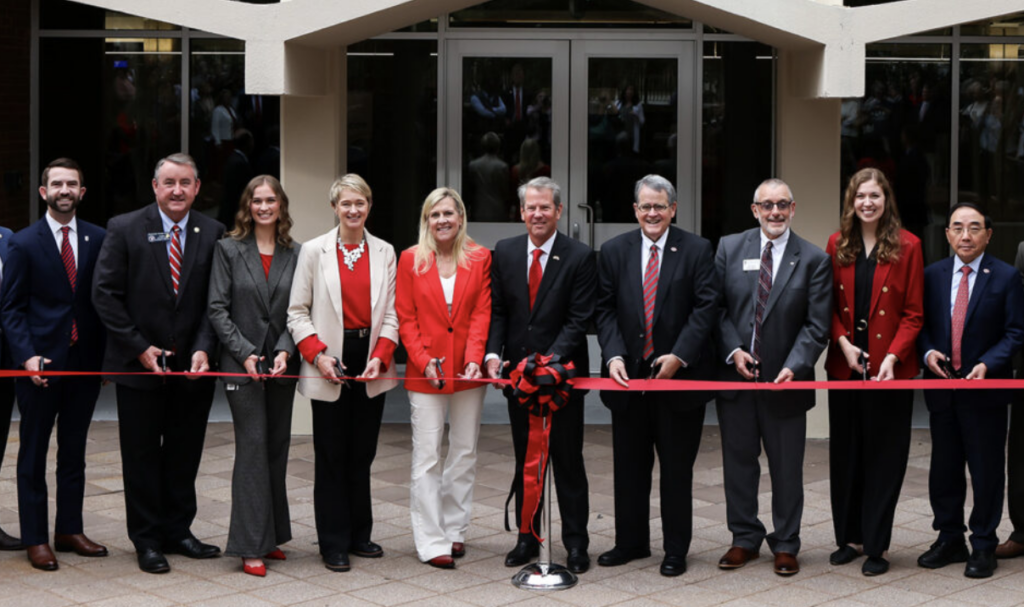Phase I focused on Cedar Street Building C, the original Chemistry building
University and state leaders cut the ribbon during the Science and Ag Hill dedication ceremony. (Chamberlain Smith/UGA)
ATHENS, Ga. – The University of Georgia held a dedication ceremony Oct. 30 to celebrate the completion of the first phase of renovations to modernize research and instructional facilities and infrastructure at UGA’s Science and Ag Hill.
This area of campus, located just south of Sanford Stadium, includes buildings dedicated to a variety of scientific disciplines such as biology, physics, geology, and agricultural sciences.
Phase I of the larger Science and Ag Hill modernization project focused on Cedar Street Building C, the original Chemistry building.
“The completion of this facility brings us another step closer to fulfilling a multi-year capital plan to build, renovate and modernize hundreds of thousands of square feet dedicated to research, instruction and innovation on Science and Ag Hill,” said UGA President Jere W. Morehead. . “We are grateful for the strong support of Governor Brian Kemp, the Georgia General Assembly, Chancellor Perdue and the Board of Regents to make this project possible.”
Originally built in 1960, Cedar Street’s Building C underwent a comprehensive renovation that began with a complete interior demolition.
The aging interior was replaced with modern laboratories and support spaces that will provide a new home for the College of Agricultural and Environmental Sciences’ entomology department, as well as the Franklin College of Arts and Sciences’ microbiology and cell biology departments. .
Features of these new spaces include open laboratories, microscopy rooms, insect holding facilities, environmental rooms and plant growth spaces.
“Connections and networks are so important, and moving into our new space has increased those opportunities tenfold,” said Taylor Medlock-Lanier, a doctoral student in cell biology. “Sharing a large lab space with four other labs in our department has already opened the door for collaborations between the groups, and I’m very excited to see what the future holds.”
Students, faculty and staff will also benefit from new conference rooms, workspaces, faculty offices and administrative suites, all of which will promote collaborative research.
“I believe the community and research environment fostered by this newly renovated building will be incredibly attractive to prospective students and faculty and will strengthen our department and the value of our degrees,” said Kelly Tims, a doctoral student in entomology.
The renovation of Cedar Street Building C follows the construction of the Science Learning Center in 2016 and the Interdisciplinary STEM Buildings, which were completed in 2021 and 2022.
In addition to the new research space, renovation and modernization of facilities is essential to keep pace with the university’s growth in research and innovation, which has been driven by advances in the fields of infectious diseases, plant sciences, behavioral research, animal health, informatics and many others.
“Part of the enduring beauty of a truth interdisciplinary research university is the cross-pollination that occurs between students from different schools and colleges,” said Anna Stanport, dean of the Franklin College of Arts and Sciences. “I am excited that tomorrow’s students and faculty will continue that rich tradition in these spaces.”
The renovation of Cedar Street’s Building C is part of a comprehensive capital strategy aimed at modernizing the Science and Ag Hill laboratories to create flexible, efficient research and teaching space that supports multiple disciplines.
“Today, as we dedicate the first phase of our Science and Ag Hill modernization, we celebrate not only a physical transformation of the research and collaboration spaces, but a renewed commitment to foster innovation and excellence in education, research and outreach.” said Nick T. Vendi, dean and director of the College of Agricultural and Environmental Sciences.
In total, more than 100,000 square feet of Cedar Street’s C Building underwent renovation.
Phase II of the Science and Ag Hill modernization project will include the renovation of the former Biological Sciences Building, now Cedar Street Building B, the university’s largest mid-century science facility. Construction on that project began earlier this month.
“Our state has grown in recent years, and UGA has always risen to meet the needs that come with that historic growth,” said Governor Kemp. “These types of prudent strategic investments will pay generational dividends.”
– University of Georgia
